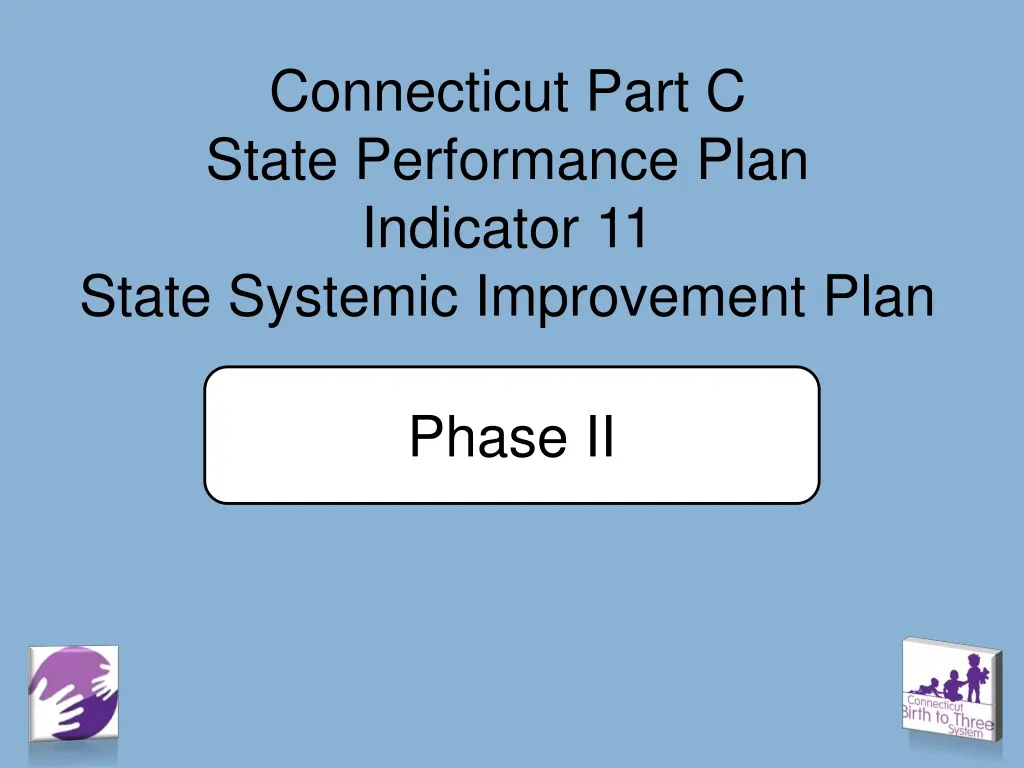
State Systemic Improvement Plan Phase II in Connecticut
Explore Connecticut's State Systemic Improvement Plan Phase II focusing on enhancing early intervention practices, supporting families, and improving outcomes for children. This plan emphasizes training, professional development, and fiscal enhancements to achieve desired results.
Download Presentation

Please find below an Image/Link to download the presentation.
The content on the website is provided AS IS for your information and personal use only. It may not be sold, licensed, or shared on other websites without obtaining consent from the author. If you encounter any issues during the download, it is possible that the publisher has removed the file from their server.
You are allowed to download the files provided on this website for personal or commercial use, subject to the condition that they are used lawfully. All files are the property of their respective owners.
The content on the website is provided AS IS for your information and personal use only. It may not be sold, licensed, or shared on other websites without obtaining consent from the author.
E N D
Presentation Transcript
Connecticut Part C State Performance Plan Indicator 11 State Systemic Improvement Plan Phase II
CT Part C SSIP Theory of Action then If Then .parents, health care providers, and EIS providersall have a shared understanding about the true purpose of early intervention visits to coach families, and .providers will implement research supported practices with fidelity including natural learning environment practices, coaching as a style of interaction with families, and the use of a primary service provider approach Education and Outreach to referral sources, parents, EIS providers and LEAs families will be better able to describe their child s abilities and challenges .all training and TA is aligned to support families as decision makers (vs. only providing therapy services to children), and so that Professional Development for parents, health care providers, and EIS providers their children receive individualized services in natural settings and demonstrate improved behavioral and educational results. and families will learn new skills and understand the unique ways that they can help their children develop and learn. .the lead agency and EIS programs revise policies, procedures, and guidelines to focus on supporting families, Fiscal Enhancements that maximize revenue and support EBPs at high quality EIS programs My son learns best by watching, parallel play, and hand over hand when he doesn't know how to move his body. My son s language is great, but he often needs reminders to take a breath before he speaks so he can be heard.
How Will We Know the Intended Outcome Was Achieved? (performance indicator) X% of practitioners passed a basic test of knowledge. Timeline (projected initiation and completion dates) Type of Outco me Measurement/ Data Collection Methods Outcome Description Evaluation Questions Short term EI practitioners have improved understanding of Natural Learning Environment Practices Did practitioners participating in training master the foundational knowledge required to implement the model? Test of knowledge administered before and after participation in training July 2015 through June 2016
How Will We Know the Intended Outcome Was Achieved? (performance indicator) X% of families idntify examples of practices that align with the EBPs being scaled up Timeline (projected initiation and completion dates) Measurement/ Data Collection Methods Type of Outcome Outcome Description Evaluation Questions Intermediate A web-based Do families access and use what is available electronic ally? Pop-up survey of the site, the content and families knowledge July 2017 through June 2018 micro-site application is available to all families about what to expect from Birth to Three.
How Will We Know the Intended Outcome Was Achieved? (performance indicator) During the Spring of 2019, 85% of families with children that have diagnosed conditions will complete the family survey with responses that result in a measure that meets or exceeds the standard for effectively communicating about their children's needs Timeline (projected initiation and completion dates) June 2019 Measurement/ Data Collection Methods Type of Outcome Outcome Description Evaluation Questions Long term [SIMR] Parents of children with diagnosed conditions will be able to describe their child s abilities and challenges. Have more families completing the family survey strongly or very strongly agreed that they can communicate more effectively with the people who work with their child and family? Data reported for APR indicator C4b, which is collected once a year using the NCSEAM survey process
Timeline (projected initiation and completion dates) Evaluation Questions How Will We Know Data to be Collected Outcome
Next Steps Draft to Website by March 4th Overview presented to programs on Mar 9 Edits to Alice by March 18th Submit Phase II by April 1st Start collecting results data for Phase III due Feb 1,, 2017
